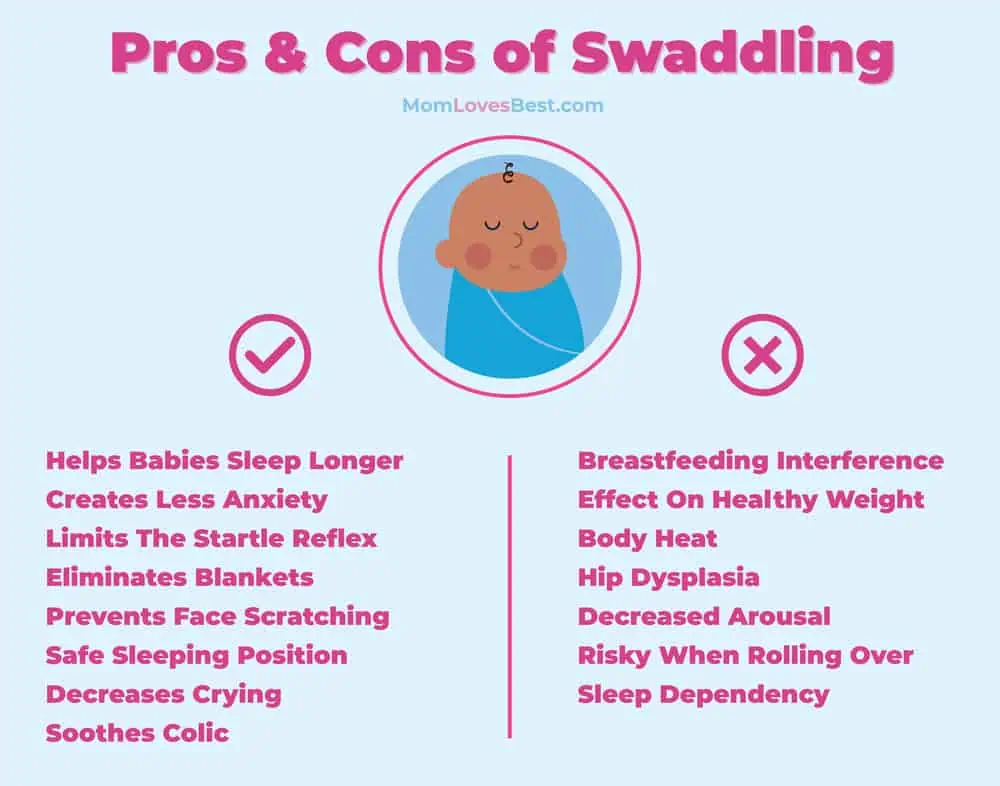Do you swaddle your baby, or are you on the fence about trying it? It seems like every grandma and neighbor swears it’s a lifesaver, yet you might have heard whispers that it could be risky.
So, what is the verdict? Is swaddling actually safe?
It is a classic parenting move, but plenty of new parents dive in without looking at the safety guidelines first.
We created this guide to clear up the confusion. We will cover the real benefits, the potential risks you need to watch out for, and exactly how to wrap your little burrito safely.
Key Takeaways
- Swaddling mimics the womb to help babies sleep longer, reduce anxiety, and limit the startle reflex.
- Improper swaddling carries risks like overheating, hip dysplasia, and increased SIDS risk if the baby rolls over.
- Always keep the hips loose to protect joint health and ensure the swaddle is snug but not constricting.
- Stop swaddling completely as soon as your baby shows signs of rolling over, usually around 2 months old.
Why Do Babies Like Swaddling?
Think about it from your baby’s perspective. They just spent nine months in a cozy, warm, tight space. The outside world is big, bright, and loud.
A swaddle mimics that tight, secure feeling of the womb. It acts as a “fourth trimester” comfort measure, helping newborns transition to life on the outside.
Many parents turn to the swaddle when their baby has a strong startle reflex (the Moro reflex) that jolts them awake. It is also a go-to move for calming a fussy or colicky infant.
Age Recommendation
Benefits of Swaddling
There is a reason this technique has been around for centuries. It works. Plus, there is a massive market for swaddle blankets designed to make the process goof-proof.
Here is why swaddling is a staple in the nursery (1):
- Improves sleep duration: Babies often feel more secure when wrapped up. The swaddle prevents their own movements from waking them, helping them link sleep cycles and stay asleep longer.
- Reduces anxiety: The gentle pressure around the body mimics being held. This touch therapy calms the nervous system and helps your baby relax faster.
- Tames the startle reflex: Newborns lack motor control. One minute they are sleeping, and the next, their arms jerk up involuntarily. This startle reflex can wake a baby from a deep sleep instantly. Swaddling keeps those arms contained so the jerking doesn’t disturb their rest.
- Safer than loose blankets: You want your baby warm, but loose bedding is a major suffocation hazard. A blanket shouldn’t be in the crib, but a swaddle is a wearable alternative. It keeps them cozy without covering their face.
- Prevents scratches: Newborn fingernails are surprisingly sharp and grow fast. Babies often scratch their faces while sleeping or rooting. A secure swaddle keeps hands away from the face, preventing those little cuts.
- Encourages back sleeping: Back sleeping is the safest position for SIDS prevention. A swaddled baby is less likely to wiggle into an unsafe position during those early weeks.
- Soothes crying: If you have a fussy baby, this might be your magic button. Research suggests swaddling can decrease crying by 42% in babies 8 weeks or younger.
- Helps with colic: Parents of colicky babies often find relief with swaddling. The containment, combined with white noise and movement, can trigger a calming reflex.
Swaddling Risks
Like most parenting tools, swaddling isn’t without downsides. Most risks come from incorrect technique or continuing the practice for too long (2).
- Breastfeeding challenges: Some studies suggest that swaddling immediately after birth might delay effective breastfeeding. Babies need skin-to-skin contact to trigger feeding instincts. In those first few days, consider using a blanket over mom and baby during cuddles rather than a tight swaddle.
- Delayed weight gain: If a baby is swaddled too often, they might miss hunger cues or sleep through feedings. Since touch is vital for thriving, ensure you get plenty of unswaddled skin-to-skin time to boost weight gain and bonding.
- Overheating: Babies cannot regulate their body temperature well. Swaddling with thick blankets or layering too many clothes underneath can cause dangerous overheating.
- Hip dysplasia concerns: If a baby’s legs are wrapped tightly straight down, it forces the hips into an unnatural position. This can lead to hip dysplasia. The legs should always be free to bend up and out, like a frog.
- Decreased arousal: While deep sleep sounds great to tired parents, deep sleep makes it harder for a baby to wake up if they are in distress. Reduced arousal thresholds are theoretically linked to SIDS (3).
- Suffocation if rolling: This is the big one. If a swaddled baby rolls onto their stomach, they cannot use their arms to push up or turn their head to breathe. You must stop swaddling the moment your baby attempts to roll (4).
- Sleep crutch: If used too long, your baby might depend on the swaddle to fall asleep. Weaning can be tricky if they rely on that tight feeling to drift off.
Safe Swaddling Tips
You can use swaddling to soothe and comfort your baby safely if you follow a few golden rules.
Here is how to keep your little one safe while they snooze.
- Watch the temperature: Avoid overheating by checking your baby regularly. Feel their chest or ears; if they are hot or sweaty, they are overdressed. Damp hair and red cheeks are red flags. Generally, dress your baby in just one more layer than you are wearing.
- Keep it secure: Loose fabric is dangerous. If the swaddle comes undone, it can cover your baby’s nose and mouth. Whether using a blanket or a velcro sack, ensure it stays put.
- The two-finger test: You want it snug, not suffocating. You should be able to fit two or three fingers between the swaddle and your baby’s chest. Too tight can restrict lung expansion (5).
- Hips must wiggle: Never bind the legs straight. Ensure the swaddle is loose from the waist down so your baby can bend their legs up and out. This protects their hip joints.
- Stop when rolling starts: This is non-negotiable. Stop swaddling as soon as your baby shows signs of rolling over. A swaddled tummy sleeper is at high risk for suffocation.
- Give them a break: Don’t keep your baby wrapped up 24/7. They need freedom to move, kick, and explore their body when awake. Save the swaddle for sleep time.
- Get a lesson: Ask a nurse or pediatrician to show you the proper technique before you leave the hospital.
Remember, not every baby loves being a burrito. If your little one fights it constantly, do not force it. You can try swaddling with their arms out or switch to a sleep sack.
Most experts recommend phasing out the swaddle by 8 weeks or at the first sign of rolling, whichever comes first (6).
FAQs
The Bottom Line
You can skip most of the risks associated with swaddling just by paying attention to the technique. Keep the top snug enough to stay put, but ensure those little hips and legs have plenty of room to wiggle like a frog.
Watch out for overheating, and remember that the swaddle is a sleep tool, not an all-day outfit. Your baby needs plenty of floor time and cuddles without the blanket, too.
Most importantly, keep an eye on those milestones. Once your baby starts trying to roll over, or hits the 2-month mark, it is time to retire the swaddle and graduate to a sleep sack.







